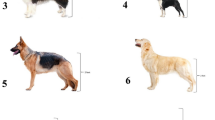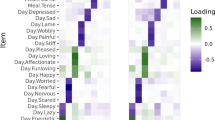Abstract
Background
Weight bias against persons with obesity impairs health care delivery and utilization and contributes to poorer health outcomes. Despite rising rates of pet obesity (including among dogs), the potential for weight bias in veterinary settings has not been examined.
Subjects/Methods
In two online, 2 × 2 experimental studies, the effects of dog and owner body weight on perceptions and treatment recommendations were investigated in 205 practicing veterinarians (Study 1) and 103 veterinary students (Study 2). In both studies, participants were randomly assigned to view one of four vignettes of a dog and owners with varying weight statuses (lean vs. obesity). Dependent measures included emotion/liking ratings toward the dog and owners; perceived causes of the dog’s weight; and treatment recommendations and compliance expectations. Other clinical practices, such as terms to describe excess weight in dogs, were also assessed.
Results
Veterinarians and students both reported feeling more blame, frustration, and disgust toward dogs with obesity and their owners than toward lean dogs and their owners (p values < 0.001). Interactions between dog and owner body weight emerged for perceived causes of obesity, such that owners with obesity were perceived as causing the dog with obesity’s weight, while lean owners were perceived as causing the lean dog’s weight. Participants were pessimistic about treatment compliance from owners of the dog with obesity, and weight loss treatment was recommended for the dog with obesity when presenting with a medical condition ambiguous in its relationship to weight. Veterinarians and students also reported use of stigmatizing terms to describe excess weight in dogs.
Conclusions
Findings from this investigation, with replication, have implications for training and practice guidelines in veterinary medicine.
This is a preview of subscription content, access via your institution
Access options
Subscribe to this journal
Receive 12 print issues and online access
$259.00 per year
only $21.58 per issue
Buy this article
- Purchase on Springer Link
- Instant access to full article PDF
Prices may be subject to local taxes which are calculated during checkout




Similar content being viewed by others
Notes
To reduce the number of comparisons, sensitivity analyses were also conducted by dividing emotion ratings into two categories of positive and negative emotions. Results were consistent with those presented here and were not included due to less specificity in emotion ratings.
References
Kushner RF, Batsis JA, Butsch WS, Davis N, Golden A, Halperin F, et al. Weight history in clinical practice: the state of the science and future directions. Obesity. 2020;28:9–17.
Alberga AS, Pickering BJ, Hayden KA, Ball GDC, Edwards A, Jelinski S, et al. Weight bias reduction in health professionals: a systematic review. Clin Obes. 2016;6:175–88.
Hebl MR, Xu J. Weighing the care: physicians’ reactions to the size of a patient. Int J Obes. 2001;25:1246–52.
Phelan SM, Burgess DJ, Yeazel MW, Hellerstedt WL, Griffin JM, Ryn M. Impact of weight bias and stigma on quality of care and outcomes for patients with obesity. Obes Rev. 2015;16:319–26.
Healy M, Gorman A. AMA declares obesity a disease. Los Angeles Times. 2013. https://www.latimes.com/science/la-xpm-2013-jun-18-lasci-obesity-disease-20130619-story.html.
Pont SJ, Puhl R, Cook SR, Slusser W. The Obesity Society. Stigma experienced by children and adolescents with obesity. Pediatrics. 2017;140:e20173034.
Kyle TK, Puhl RM. Putting people first in obesity. Obesity. 2014;22:1211.
Stanford FC, Kyle TK. Respectful language and care in childhood obesity. JAMA Pediatr. 2018;172:1001–2.
Manson JE, Skerrett PJ, Greenland P, Vanltallie TB. The escalating pandemics of obesity and sedentary lifestyle: a call to action. Arch Intern Med. 2004;164:249–58.
Farcas AK, Michel KE, editors. Small animal obesity. Veterinary Clinics of North America: small animal practice. Philadelphia, PA: Elsevier; 2016.
Bartges J, Kushner RF, Michel KE, Sallis R, Day MJ. One Health solution to obesity in people and their pets. J Comp Pathol. 2017;156:326–33.
German AJ, Holden SL, Brennan L, Burke C. Dangerous trends in pet obesity. Vet Rec. 2018;182:25.
Hamlington B, Ivey LE, Brenna E, Biesecker LG, Biesecker BB, Sapp JC. Characterization of courtesy stigma perceived by parents of overweight children with Bardet-Biedl Syndrome. PLoS ONE. 2015;10:e0140705.
Holub SC, Tan CC, Patel SL. Factors associated with mothers’ obesity stigma and young children’s weight stereotypes. J Appl Dev Psychol. 2011;32:118–26.
Cohen J. Statistical power analysis for the behavioral sciences. Second Edition. Hillsdale, NJ: Lawrence Erlbaum Associates, Publishers; 1988.
CRW VanVoorhis, Morgan BL. Understanding power and rules of thumb for determining sample sizes. Tutor Quant Methods Psychol. 2007;3:43–50.
Sabin JA, Marini M, Nosek BA. Implicit and explicit anti-fat bias among a large sample of medical doctors by BMI, race/ethnicity and gender. PLoS ONE. 2012;7:e48448.
McCleary-Gaddy AT, Miller CT, Grover KW, Hodge JJ, Major B. Weight stigma and hypothalamic-pituitary-adrenocortical axis reactivity in individuals who are overweight. Ann Behav Med. 2019;53:392–8.
Pearl RL, Argueso D, Wadden TA. Effects of medical trainees’ weight-loss history on perceptions of patients with obesity. Med Educ. 2017;51:802–11.
Ruttan RL, McDonnell M, Nordgren LF. Having “been there” doesn’t mean I care: When prior experience reduces compassion for emotional distress. J Pers Soc Psychol. 2015;108:610–22.
Pearl RL, Lebowitz MS. Beyond personal responsibility: effects of causal attributions for obesity on weight-related beliefs, stigma, and policy support. Psychol Health. 2014;29:1176–91.
Chandler ML Impact of obesity on cardiopulmonary disease. Farcas AK and Michel KE, editors. Philadelphia, PA: Elsevier; 2016.
Puhl RM, Peterson JL, Luedicke J. Motivating or stigmatizing? Public perceptions of weight-related language used by health providers. Int J Obes. 2013;37:612–9.
Puhl RM, Peterson JL, Luedicke J. Parental perceptions of weight terminology that providers use with youth. Pediatrics. 2011;128:786.
Wadden TA, Didie E. What’s in a name? Patients’ preferred terms for describing obesity. Obes Res. 2003;11:1140–6.
Volger S, Vetter ML, Dougherty M, Panigrahi E, Egner R, Webb V, et al. Patients’ preferred terms for describing their excess weight: discussing obesity in clinical practice. Obesity. 2012;20:147–50.
Phelan SM, Dovidio JF, Puhl RM, Burgess DJ, Nelson DB, Yeazel MW, et al. Implicit and explicit weight bias in a national sample of 4732 medical students: The medical student CHANGES study. Obesity. 2014;22:1201–8.
O’Brien KS, Puhl RM, Latner JD, Mir AS, Hunter JA. Reducing anti-fat prejudice in preservice health students: A randomized trial. Obesity. 2010;18:2138–44.
Chapman EN, Kaatz A, Carnes M. Physicians and implicit bias: How doctors unwittingly perpetuate health care disparities. J Gen Intern Med. 2013;28:1504–11.
MacInnis CC, Alberga AS, Nutter S, Ellard JH, Russell-Mayhew S. Regarding obesity as a disease is associated with lower weight bias among physicians: a cross-sectional survey study. Stigma Health. 2020;5:114–22.
Nutter S, Alberga AS, MacInnis C, Ellard JH, Russell-Mayhew S. Framing obesity as a disease: Indirect effects of affect and controllability beliefs on weight bias. Int J Obes. 2018;42:1804–11.
Ata RN, Thompson KJ, Boepple L, Marek RJ, Heinberg LJ. Obesity as a disease: effects on weight-biased attitudes and beliefs. Stigma Health. 2018;3:406–16.
McVay MA, Steinberg DM, Askew S, Kaphingst KA, Bennett GG. Genetic causal attributions for weight status and weight loss during a behavioral weight gain prevention intervention. Genet Med. 2016;18:476–82.
Hilbert A. Weight stigma reduction and genetic determinism. PLoS ONE. 2016;11:e0162993.
Acknowledgements
R.L.P. is supported by a K23 Mentored Patient-Oriented Research Career Development Award from the National Heart, Lung, and Blood Institute of the NIH (K23HL140176).
Author information
Authors and Affiliations
Corresponding author
Ethics declarations
Conflict of interest
The authors declare that they have no conflict of interest.
Additional information
Publisher’s note Springer Nature remains neutral with regard to jurisdictional claims in published maps and institutional affiliations.
Supplementary information
Rights and permissions
About this article
Cite this article
Pearl, R.L., Wadden, T.A., Bach, C. et al. Who’s a good boy? Effects of dog and owner body weight on veterinarian perceptions and treatment recommendations. Int J Obes 44, 2455–2464 (2020). https://doi.org/10.1038/s41366-020-0622-7
Received:
Revised:
Accepted:
Published:
Issue Date:
DOI: https://doi.org/10.1038/s41366-020-0622-7



